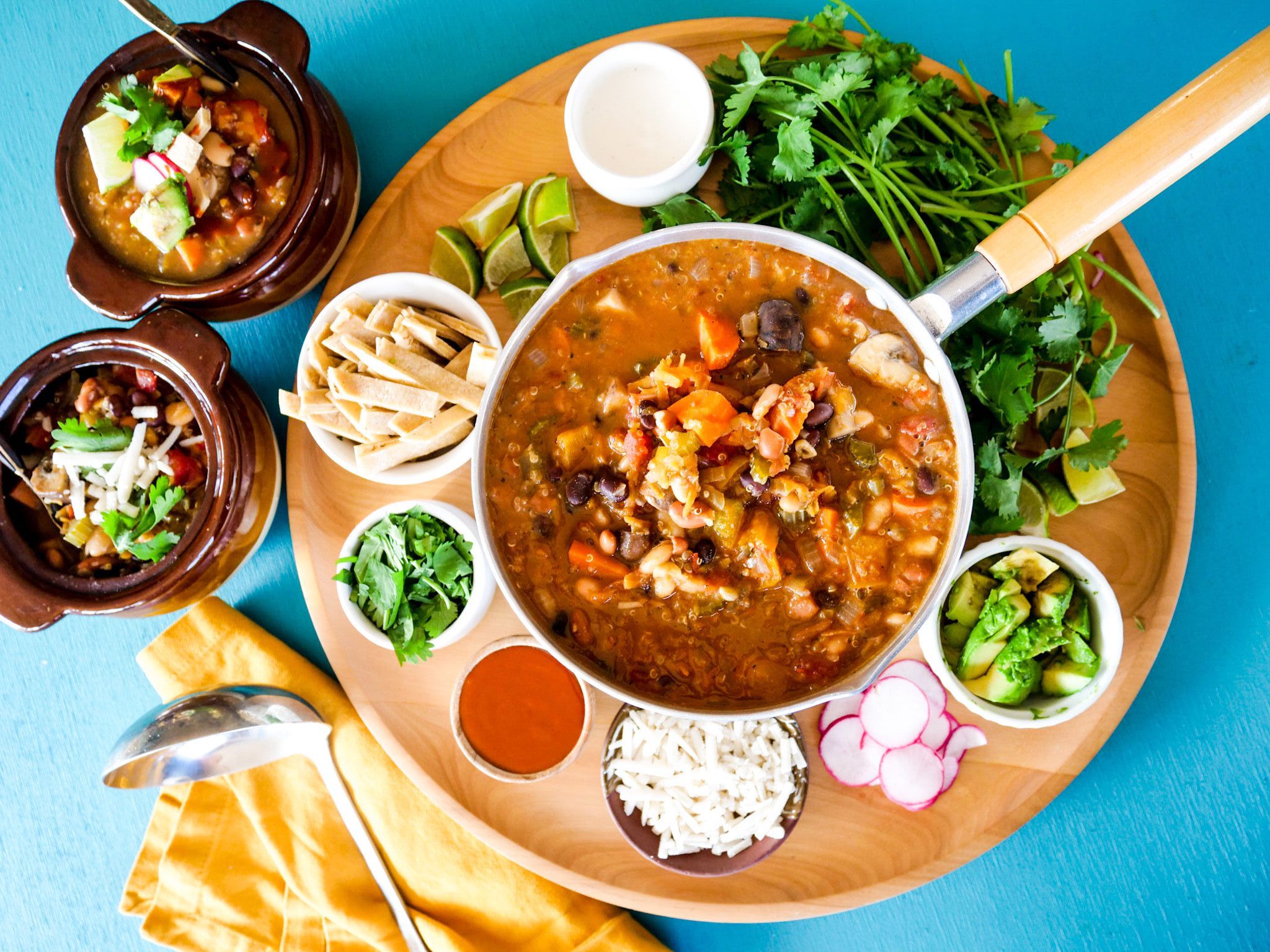Master the Art of Plant-Based Cooking With the Five Elements of Flavor, According to a Chef
It turns out the secret to enjoying a plant-based diet isn’t discipline, it’s playing with your food. The five elements of flavor, that is.

There’s a common misconception in the western world that plant-based food is flavorless, but nothing could be further from the truth when you know what you’re doing. Learn to play with the five pillars of flavor as well as other components of good cooking and you’ll enjoy everything you eat. For me, it’s fresh local strawberries right out of the basket, or the flavor bomb of the watermelon poke bowl out of my cookbook, or the rich, creamy joy of an Alfredo sauce.
Flavor and Your Health and Tied Together
As a professional French-trained chef, I learned long before I was plant-based that flavor comes from various sources, but most people lean into only three – fat, salt and sweet (which is also the base of French cooking). The most addictive and unhealthy foods also fall into this category since they are the pillars of meat-based diets and processed foods. Don’t get me wrong – those three flavors are essential to creating a delicious, balanced meal, but don’t stop there! When we bring in other flavor components like sour and umami, as well as consider things like seasonality, a whole new world opens up, blending good flavor with health.
Plants Are Important in Any Diet
Plants are already an important part of any diet, even those including meat. When you think about the base of a favorite marinade, or salad dressing, or breakfast dish, more than likely that dish includes plants. You would never put a piece of chicken in boiling water and serve it up just like that – you would flavor it with herbs, spices, lemon. Maybe you’d cook it on a cast iron for a little extra something special.
And if you take out the meat, the same concepts work. Tofu by itself is not a flavor explosion, but with the right marinade, cooked on a cast-iron, it’s delicious! With its ability to absorb flavor, tofu is one of my favorite clean protein sources.
The Five Elements of Flavor
When building flavor, I begin with the following five elements: salty, sweet, sour, spicy, and umami. Once I assess the balance between those flavors, I consider things like texture, fat, and seasonality. All of these components can make or break a dish

Once you know what to consider, you can easily fix a sauce that’s too flat, tone down a spicy dish, or add complexity to a dessert.
At first, it may feel overwhelming to think about all of these things when cooking, but once you get the hang of it, you’ll be able to build and tweak flavor in any recipe, plant-based or not.
1. Salt

Salt is the sort of simple ingredient that is noticeable only if there’s too much or not enough. With its ability to bring out the natural flavors of food, salt can truly enhance any dish. However, balance is key; nobody wants a mouthful of salt. Luckily, if you find that your dish is too salty, you can add a bit of fat to balance out the flavor (olive oil, plant-based yogurt, avocado, cashew cream, etc.). You can also change a dish’s flavor by changing the salt, since there are many different kinds. My favorite example of this is adding black salt to a plant-based “egg” dish to give it more of a sulfur flavor. Try it, and tell me you don’t think you’re eating eggs!
2. Sweet

When adding a touch of sweetness, think bigger than just dessert or breakfast. Adding a touch of sweetness from coconut sugar, maple syrup, agave or date nectar can balance out the best savory dishes, complementing acidity as well as spice and umami. I love to add coconut sugar to caramelized onions or yellow curry. A dash of maple syrup to chickpeas with spices helps them get nice and crunchy in the oven. Adding coconut aminos and maple syrup to Thai peanut dressing complements the umami flavor. The possibilities are endless!
3. Sour and Bitter

For sour flavors, turn to vinegars and citrus. Sour flavors can make flat dishes spring to life, as well balancing those that are high in fat. For example, I always squeeze a lemon into that alfredo sauce I mentioned, to help brighten and lighten so it’s not so heavy on the palette. I also am a huge fan of “cooking” things with citrus and salt, like the cauliflower ceviche in my cookbook. Citrus is the base for the marinade, with a delicious balance of orange for sweet, lime and lemon for sour, jalapeño for spicy, and avocado for fat. It truly has all the elements! And if you find your dish is too sour or too vinegary, add a touch of sweetness or fat.
4. Spices

Working with spice is not only for those who toss hot sauce on everything. The element of spice offers so much more, adding complexity, interest, and layers of flavor. Add chili paste to the beginning stages of a ramen. A little jalapeño to guacamole. Or chili powder to a lentil dish. Adding spice doesn’t mean that the dish itself will be spicy. Use small amounts and build layers of flavor that otherwise wouldn’t be possible. If you’re someone who shies away from using those kinds of ingredients, I would highly recommend stepping out of the comfort zone to experience the possibilities.
5. Umami

Umami can remind some of MSG-heavy takeout, but the word literally means the “essence of deliciousness” in Japanese, which offers a little hint of the importance of this flavor. Foods that are strong on umami are soy sauce, mushrooms, wasabi, tomatoes, seaweed, and fermented foods. It’s that earthy flavor that you can’t quite put your finger on.
Other Components of Flavor Building

Texture and Temperature
Texture and temperature can expand the way you view food outside of the five pillars of flavor. Adding different textures and temperatures to every dish gives your palette something to grab onto and think about. My favorite example of this is my watermelon poke bowl. You get a crispy cold umami flavor and texture from the watermelon, chewy warmth from the rice, crunchy coldness from the cucumber, and a soft finish with the avocado and spicy crema. Are you hungry yet?!
Fat

Fat is such a key player in flavor, but since heart disease is the number one killer of Americans, I want to highlight whole, plant-based sources of fat. Any fat in a dish is like a warm hug to our palette; there’s no replacement for it. Luckily there are plenty of whole, plant-based sources that will satisfy your palate while increasing health. Avocados, nuts, seeds, coconut, and dark chocolate are some of my favorites. Some examples of dishes made with plant-based fats: mousse from avocado; sour cream from cashews; “tuna” from sunflower seeds; heavy cream from coconut; and chocolate, which needs no introduction.
Seasonality

There is no substitute for sourcing food in season. It’s time for strawberries in San Diego, and today I had a fresh farmers market strawberry that could not compare to the kind you’d buy in the grocery store in winter. It was so sweet, so flavorful, so bright. The same goes for any produce. There are other benefits to buying in season, like getting food from farms closer to you, food that’s been grown outside rather than in a greenhouse. And buying food from your region means it doesn’t have to travel as far. This means you get more nutrients and flavor. Before planning your meals, do a quick Google search to figure out what’s in season in your area right now. This is one of the easiest ways to get the most out of your food.
Playing with flavor building and other elements of good cooking when working with plant-based foods will not only bring you more pleasure, but also more health. Get started today!
Looking for more? Follow Chef Bai over on Instagram and Tiktok (@chef_bai) to get cooking tips, free recipes and more!
COOK. HEAL. GO VEGAN! A Delicious Guide to Plant-Based Cooking for Better Health and a Better World by Bailey Ruskus – Chef Bai. With the guidance of professional plant-based chef Bailey Ruskus, adopting a whole-food, plant-based lifestyle is full of fun and flavor. Learn to make easy, nutrient-dense dishes you’ll want again and again, while inviting purpose and intention into every meal. Bailey lives in San Diego, CA.

